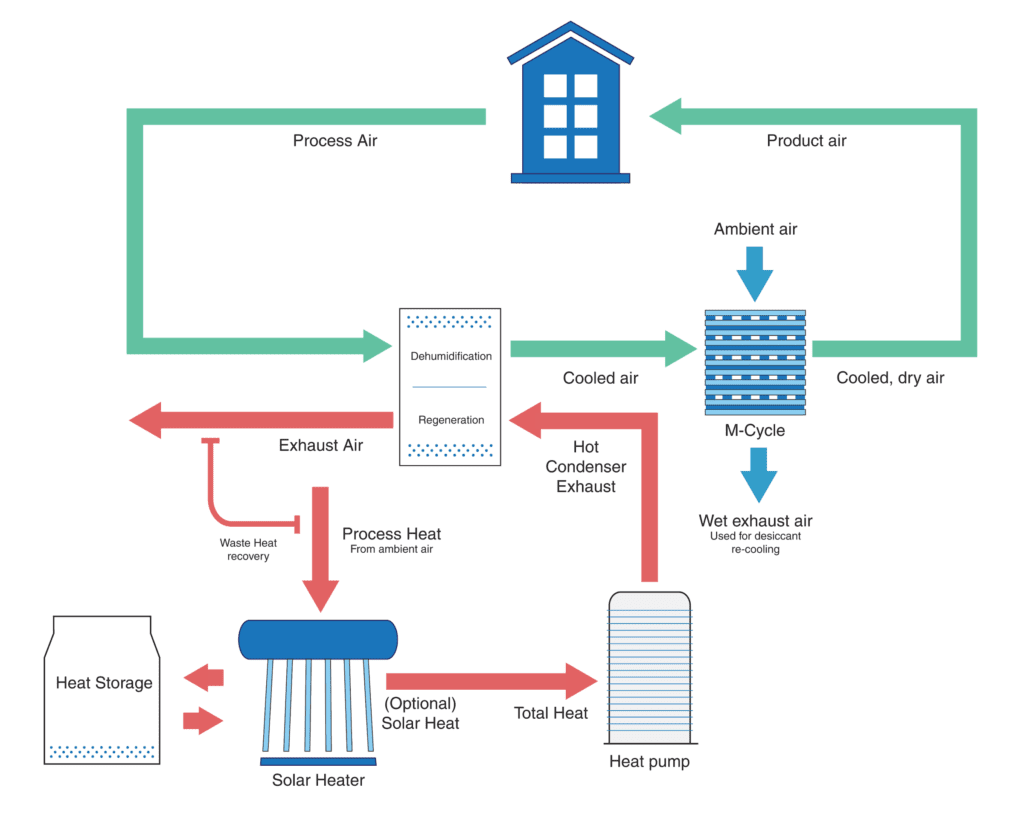Research
Research
Air conditioner: Desiccant integrated with Heat pump and Maisotsenko Cycle.
Heat Pump
Heat pumps are gaining popularity on a global scale due to their ability to provide both heating and cooling. Heat pump refrigerants have now become very eco-friendly, and every major brand updates its technology to operate at higher efficiencies in extreme climate situations.
However, heat pump efficiency is significantly lower for cooling operations in the summer as the device pumps heat against the natural thermal gradient. In summer, heat pumps operate at their maximum efficiency when they are used for heating instead of cooling. This proposal presents a thermal inverter that generates a cooling effect by using heat pumps to get leverage from naturally elevated temperatures.
Desiccant Dehumidifier
Often used for industrial dehumidification, desiccant materials can be used to absorb moisture from the air and are generally regenerated using heat-driven resources like electric, solar, or fossil fuels. Desiccant dehumidification has been conducted with inefficient materials for most residential and commercial applications because more efficient liquid desiccant materials require high maintenance. Also due to high regeneration temperature heat pump that provides better energy efficiency than other regeneration sources, are not usually used to regenerate desiccants. However, there has been some recent industrial development in highly compact, low-maintenance desiccant materials that offer high efficiencies and can be regenerated at a lower temperature. Due to lower regeneration temperature heat pumps become feasible to integrate with desiccants. Composite desiccants have only recently become available in the open market and can be used for different applications as a first mover.
Heat Pump
Heat pumps are gaining popularity on a global scale due to their ability to provide both heating and cooling. Heat pump refrigerants have now become very eco-friendly, and every major brand updates its technology to operate at higher efficiencies in extreme climate situations.
However, heat pump efficiency is significantly lower for cooling operations in the summer as the device pumps heat against the natural thermal gradient. In summer, heat pumps operate at their maximum efficiency when they are used for heating instead of cooling. This proposal presents a thermal inverter that generates a cooling effect by using heat pumps to get leverage from naturally elevated temperatures.
Desiccant Dehumidifier
Often used for industrial dehumidification, desiccant materials can be used to absorb moisture from the air and are generally regenerated using heat-driven resources like electric, solar, or fossil fuels. Desiccant dehumidification has been conducted with inefficient materials for most residential and commercial applications because more efficient liquid desiccant materials require high maintenance. Also due to high regeneration temperature heat pump that provides better energy efficiency than other regeneration sources, are not usually used to regenerate desiccants. However, there has been some recent industrial development in highly compact, low-maintenance desiccant materials that offer high efficiencies and can be regenerated at a lower temperature. Due to lower regeneration temperature heat pumps become feasible to integrate with desiccants. Composite desiccants have only recently become available in the open market and can be used for different applications as a first mover.
Maisotsenko Cycle (M-cycle)
It is used to sensibly cool the air up to 120% of the wet bulb temperature. Like an evaporative cooler, it is also energy efficient and uses water for cooling, but it cools the air without adding any humidity in the product air. In hot and low humid regions, the m-cycle has the capability to reduce air temperature up to 16°C but in high humid regions, its capacity is limited up to 23°C to 26°C only. If the input air is dehumidified before going to the m-cycle, then the product air temperature can be controlled and reduced. So, m-cycle has high potential and compatibility to integrate with desiccant-based dehumidifier for an efficient and controlled cooling process.
Our Design

Our Design

Maisotsenko Cycle Prototype (M-cycle)

Maisotsenko Cycle (M-cycle)
It is used to sensibly cool the air up to 120% of the wet bulb temperature. Like an evaporative cooler, it is also energy efficient and uses water for cooling, but it cools the air without adding any humidity in the product air. In hot and low humid regions, the m-cycle has the capability to reduce air temperature up to 16°C but in high humid regions, its capacity is limited up to 23°C to 26°C only. If the input air is dehumidified before going to the m-cycle, then the product air temperature can be controlled and reduced. So, m-cycle has high potential and compatibility to integrate with desiccant-based dehumidifier for an efficient and controlled cooling process.
Maisotsenko Cycle Prototype (M-cycle)
It is used to sensibly cool the air up to 120% of the wet bulb temperature. Like an evaporative cooler, it is also energy efficient and uses water for cooling, but it cools the air without adding any humidity in the product air. In hot and low humid regions, the m-cycle has the capability to reduce air temperature up to 16°C but in high humid regions, its capacity is limited up to 23°C to 26°C only. If the input air is dehumidified before going to the m-cycle, then the product air temperature can be controlled and reduced. So, m-cycle has high potential and compatibility to integrate with desiccant-based dehumidifier for an efficient and controlled cooling process.
